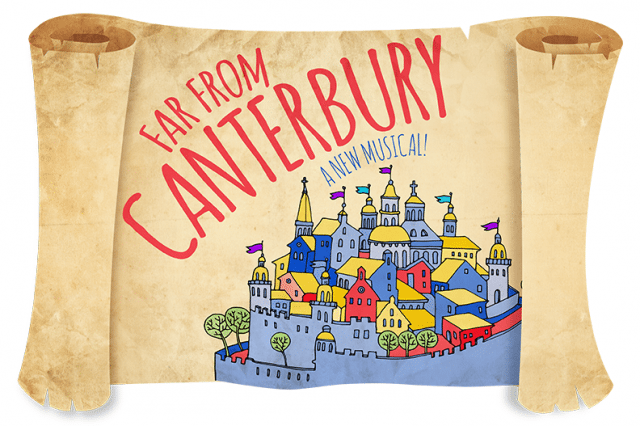
 The set design in Far From Canterbury is rather simple, prop designer Riw Rakkulchon, relies exclusively on four wooden crates and four flagpoles which are re-purposed throughout to emulate everything from regal thrones, to haunted towers and grand ballrooms. Why mention the production design before anything else? Because its effectiveness sums up the wonderment evoked by the entire show; even though you are aware that there’s no way a castle could fit inside Theatre 80, you don’t doubt for a second that the crates on that stage are anything other than what the characters believe them to be. That is called magic.
The set design in Far From Canterbury is rather simple, prop designer Riw Rakkulchon, relies exclusively on four wooden crates and four flagpoles which are re-purposed throughout to emulate everything from regal thrones, to haunted towers and grand ballrooms. Why mention the production design before anything else? Because its effectiveness sums up the wonderment evoked by the entire show; even though you are aware that there’s no way a castle could fit inside Theatre 80, you don’t doubt for a second that the crates on that stage are anything other than what the characters believe them to be. That is called magic.
It helps that the wizardry going on in the show is anchored by a brilliant book, music and lyrics by Danny K. Bernstein, who like the heroes in his show, took on the herculean task of trying to bring a sense of freshness to something as trite as fairy tales. It’s these very tales, in particular Chaucer's The Wife of Bath's Tale, which in fact set our hero John of Bath (Luke Hoback) along in his quest, for he wishes more than anything to break the “curse” that has left him incapable of speaking to women. Despite him being the best songwriter in the county, he finds it impossible to connect two syllables whenever he’s in front of a woman. John often wishes he was as dashing as the knights in the fairy tales that are distributed among the townspeople, which in this particular take carry the power of religious pamphlets and modern tabloids. One day John finds himself being the subject of one of the tales which accuses him of taking a sleeping maiden from her tower and then abandoning her. Unless he wants to be hanged for his crimes, the Queen (Sarah Coffey) offers him the opportunity to atone for his sins by going on a quest and figuring out “what is the one thing that women desire the most”.
John recruits his two best friends in the world to come along with him, Marcus (T.J. Wagner) is an “extremely handsome” lothario who has made a career for himself by giving women the pleasure their partners deny them, while Agnes (Hannah Richter) is a tomboy-ish young lady unsure as to why her father expects her to marry a man she barely knows. By going with John, Marcus and Agnes expect to also find answers to their own questions.
Populated with memorable characters like the kooky oracle Dolores (Katie Drinkard) and the hyper-macho Nicolas (Josh Archer) who spews lines drenched in testosterone, all of whom play with the conventions of medieval fantasy, Far From Canterbury inevitably recalls similar works like Shrek and Spamalot, but with its existential quest and funk-infused score Pippin is perhaps its closest relative. As in Stephen Schwartz’s iconic musical, we find ourselves wondering whether we should be rooting for a hero affected with indecision and imperfection. Hoback infuses John with a lovable quality that not for a second exempts him from the fact that he can be kind of a jerk. Like John, each and every character in the show is presented as a complex, often conflicting being, which makes for theatre that challenges as it entertains.
The fun value of Far From Canterbury is quite high, but the show excels because it’s so focused and tightly constructed, that even though it seems to be straying at times, it finds its way back to where it needs to go. Bernstein’s complex Russian doll structure offers flashbacks within flashbacks, parallel storylines in different timelines which allow for a sense of making the show seem as if it’s being written as it unfolds.
As the show reaches its climax, it’s safe to be concerned with whether it will be able to fulfill its promise or not, and considering how underwhelming or moralizing revisionist fairy tales tend to be, the wisdom imparted by Far From Canterbury is fulfilling because it follows the adage that suggests that we know universal truths to be true when upon first hearing them we feel like we knew them deep inside all along. Far From Canterbury is wise, and funny and so progressive, that its very existence feels like something out of a fairy tale.